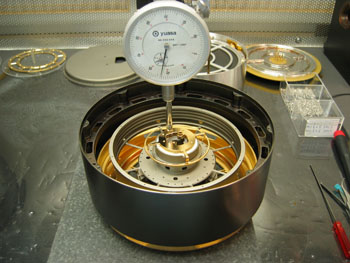Meet the IBEX Team: Roger Kraus

As a college freshman at Penn State University, Roger Kraus thought he would follow in his father's footsteps and settle into an electrical engineering career with NASA. Along the way, he encountered a big problem. "I couldn't understand electrical engineering for the life of me!" Roger said.
Instead, Roger tried his hand at mechanical engineering. It was the perfect type of engineering for someone who loves getting away from his desk and getting his hands dirty. "You can visualize it, and work with your hands. It's much easier to understand what is going on than with electrical engineering," he said.
Today, Roger is a structural analyst/mechanical systems engineer at Swales Aerospace in Maryland, near Washington D.C. He has worked there since 1990. For the IBEX mission, Roger provides oversight for the Goddard Space Flight Center (GSFC) on mechanical issues. This means that he makes sure that the contractors working on different parts of the IBEX spacecraft are as far along on the projects as they say they are, and that no aspect of the project gets overlooked. "No one presents the bad stuff, and sometimes there are things that aren't covered. I try to help management figure out what is going on and what to do next," Roger said.
The most exciting part of Roger's job is testing and pre-test analysis of spacecraft. Because IBEX is equipped with extremely sensitive instruments, the IBEX team needs to know if the spacecraft can withstand the vibrations it will encounter as it is launched into space on a powerful rocket.
Roger provides oversight and assistance to the Explorer's program for vibration testing "Orbital Sciences has a 'shaker table' that has the ability to reproduce the loads that the rocket will have on it. You just shake it! There are tables and software that shake the hardware to a pre-programmed environment, and accelerometers measure how the spacecraft is reacting to what you're putting on the table," Roger said. The spacecraft's equipment is so sensitive and valuable that the team even does significant pre-test analysis to make sure that anything going onto the "shaker table" can withstand the test.
In the last month, Roger has been supporting vibration testing on a model of the IBEX spacecraft that includes objects that are the same mass as the spacecraft's components and sensors, called "mass mock-ups". Roger explained, "A spacecraft in its final configuration has got a lot of delicate sensors on it, so for this test we just have the flight hardware on it with hunks of metal with the same mass as the sensors. We're just trying to understand how the spacecraft reacts without the expensive instruments on it that are still being built."
Although the engineers can predict how violently a rocket will shake the spacecraft on launch, they make sure it can withstand even harsher vibrations. "We typically test a worse environment than we know the [spacecraft] is going to get at launch. That way, you're a little more comfortable!" Roger said.
Roger has found that much of what he learned at Penn State has been essential in helping him succeed in his job. "My college education was very beneficial to performing my job. I regularly consult with textbooks from school. I also use basic equations of motion, Newton's Laws, F=MA - things in their simplest forms that I use everyday," he said. He recommends that students hoping to pursue a career in mechanical engineering should "Learn your math and physics. I can honestly say that I use what I learned in school on a regular basis."
Roger didn't always want to be an engineer. As a kid playing tons of baseball and participating in church activities in the Washington D.C. area, Roger thought he might grow up to be a major leaguer or a keyboardist for a band. "I think I had a realization that I wasn't going to be making money doing those things. I wasn't that good!" he said. He still plays softball in a church league, and his daughter plays the piano. He devotes his free time to improving his new house and reading for pleasure.
Even though his father worked in the aerospace industry, Roger found that being an aerospace engineer is not as clear-cut as he thought. "As an engineer, I like to think that things are black and white. But in reality there are many shades of gray, even in engineering. Weighing technical issues against cost/schedule is often the most difficult aspect of the job," he said. He also finds it challenging to come to terms with the fact that he cannot set the schedule for a spacecraft. "Realizing that at times I am not in control of my schedule [is a challenge]. There are certain parts of a satellite program where things just need to get done on compressed schedules."
Still, Roger finds the job extremely rewarding. "What I've been doing for IBEX and for other satellites and small explorer missions has been a good opportunity to meet a lot of folks at a lot of institutions and within NASA. It's been one of the most enjoyable parts of it, because you're not sitting behind your desk all the time. It's also been a good opportunity for travel, and you get to see a lot of new places. It has really broadened my mechanical engineering experiences," Roger said.
Roger is unsure what the future of space travel will bring, but he knows he will be a part of it. "I'm sure we'll still be exploring space, whether we'll be going to Mars or building shuttles or studying Earth science. Whatever we do, it has to get built and launched, so I think I'll always have something to do," Roger said. Let's hope he gets to get his hands dirty!
